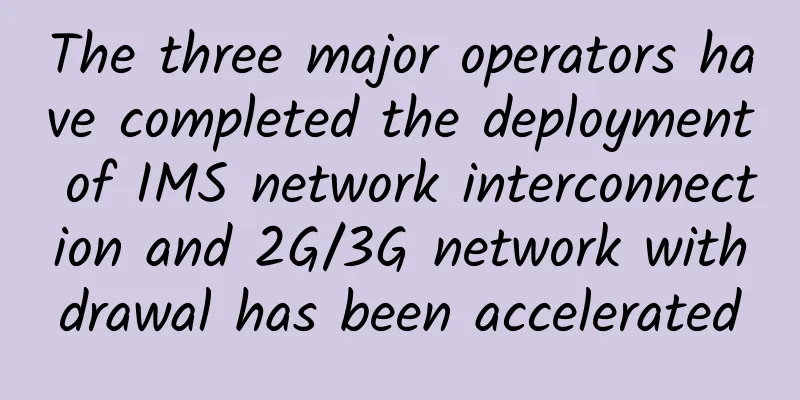The three major operators have completed the deployment of IMS network interconnection and 2G/3G network withdrawal has been accelerated

|
Recently, the three major operators completed the deployment of IMS network interconnection in the national mobile communication network and officially provided services to users. This has accelerated the transition of 2G and 3G users to 4G/5G and the withdrawal of 2G/3G networks. The three major operators have completed the deployment of IMS network interconnectionIt is understood that the Ministry of Industry and Information Technology previously organized China Telecom, China Mobile, and China Unicom to carry out IMS network interconnection work, and completed the national mobile communication network IMS network interconnection deployment in August 2021, officially providing services to users. The so-called IMS, or IP Multimedia Subsystem technology, is a layered, open, and integrated communication core network built on the operator network using IP technology. It has become the standard core network architecture in the all-IP era. Through the IMS network, users can enjoy rich telecommunications-grade multimedia services such as high-definition audio/video calls, video ringback tones, and telephone conferences. After years of development and maturity, IMS has now crossed the chasm and become the mainstream choice for VoBB and PSTN network transformation in the fixed voice field. It has also been determined by 3GPP and GSMA as the standard architecture for mobile voice. Currently, China Telecom, China Mobile and China Unicom have all completed IMS network deployment. In fact, as early as February 2019, the Ministry of Industry and Information Technology organized a pilot project for IMS network interconnection in Hunan and Sichuan provinces. The pilot services included basic language services, supplementary services, point-to-point video calls, ringback tone, and telephone conferences. In May 2020, based on the success of the pilot projects in the two provinces, the Ministry of Industry and Information Technology decided to promote IMS network interconnection nationwide. At the same time, under the organization of the Ministry of Industry and Information Technology, China Telecom, China Mobile, China Unicom and China Academy of Information and Communications Technology have researched and formulated technical solutions, test specifications and more than 10 industry standards, carried out more than 100,000 network tests, covering more than ten types of network element equipment from five mainstream equipment manufacturers, and completed service cutover adjustments in batches in an orderly manner. The Ministry of Industry and Information Technology stated that after the IMS networks are interconnected, the inter-network communication experience of 4G/5G users will be significantly improved: first, it will effectively reduce the inter-network call delay and reduce the waiting time for users to communicate across operators; second, it will significantly improve the quality of inter-network calls, with higher audio restoration and more realistic sounds heard by users; third, it will support richer multimedia applications, and users can use services such as video calls and video ringback tones across operators. Of course, if the VoLTE/VoNR of the three major operators can be interconnected nationwide, it will accelerate the migration of 2G and 3G users to 4G/5G, so that the 2G and 3G network withdrawal speed will be faster. After all, the key to 2G and 3G network withdrawal is still voice, because VoLTE/VoNR voice solutions are built on the IMS architecture and require the support of IMS. 2G/3G network withdrawal is acceleratingToday, there is a global spectrum shortage. As of the end of February 2021, only about 40 regional markets in the world have issued new 5G frequency bands. Operators in other places can only use the existing old frequency bands at this stage. In this case, operators have to consider shutting down the old standard network and transferring the frequency band to the new standard network. GSMA predicts that by 2025, more than 55 2G/3G networks will be shut down worldwide, using spectrum and site resources for 4G/5G networks. More and more operators are shutting down 2G/3G networks: According to GSMA statistics, 19 operators in 14 European countries plan to shut down 3G by 2025, while only 8 operators in 8 countries plan to shut down 2G at the same time; by the end of 2025, 15 operators in 7 countries in the Americas will shut down 2G networks and reuse 2G spectrum for 4G and 5G network services; it is expected that by the end of 2025, 29 operators in Asia will shut down 2G and 16 operators will shut down 3G. The Ministry of Industry and Information Technology has long publicly stated that the conditions for the withdrawal of 2G and 3G networks have gradually matured, and operators are encouraged to actively guide users to migrate and switch networks, and use limited frequency and network resources in the development of 4G/5G networks to reduce overall costs. In March this year, Wang Xiaochu, then chairman of China Unicom, said: "China Unicom's current strategy is to accelerate the withdrawal of 2G networks. It is expected that all 2G networks will be withdrawn within this year. Since it will take some time for 5G networks to become popular, 3G needs to be retained for a while." China Telecom has already started to withdraw from the 3G network. Starting from June 1, 2020, China Telecom will gradually shut down its 3G network in Yunnan. Starting from 2020, China Telecom requires that all 5G terminals must not have CDMA frequency bands and standards, and that VoLTE switches must not be allowed. If CDMA frequency bands and standards have been reported, the removal schedule must be clearly specified, and CDMA frequency bands and standards are not allowed in the final network access certificate and model approval certificate. In addition, as early as last year, 3GPP announced at the RAN#88e plenary meeting that the RAN6 working group responsible for GERAN and UTRAN radio and protocol work was officially closed. The RAN6 working group had previously been responsible for studying 2G and 3G radio functions and defining specifications and interfaces involving GSM/EDGE radio access networks (GERAN) and UMTS radio access networks (UTRAN). In other words, the closure of the RAN6 working group means that the 2G/3G network withdrawal has been implemented at the standard level. |
<<: Do you really understand the connection control in Dubbo?
Recommend
[Black Friday] RackNerd: Multi-datacenter VPS annual payment starts from $10.88
RackNerd's Black Friday promotion has been la...
The average monthly salary of 5G talents exceeds 14,000 yuan, and Beijing, Shanghai and Shenzhen are most in need of talent
As 5G commercialization approaches, the demand fo...
Appreciation of 21 foreign website 404 page designs
Whenever a "404 error" appears when bro...
Can the three major operators jointly develop Fetion to compete with WeChat?
A recent tender notice from China Mobile has brou...
Fiber will play a key role in 5G development
CommScope recently said that in the future of bro...
Detailed explanation of TCP data segment format + UDP data segment format
TCP Message Format TCP (Transmission Control Prot...
A Preliminary Study on Microsecond-Level High-Performance Network
If we expect to reduce network latency from 10ms ...
South Korea plans to launch 6G network services in 2028, two years ahead of schedule
South Korea plans to launch sixth-generation netw...
How to ensure the reliability and number of nodes in CAN network communication
In CAN-bus circuit design, the transceiver can th...
TSMC factory suddenly outages! May lose 200 million yuan, 30,000 wafers damaged
According to Taiwanese media reports, yesterday m...
Don’t just focus on SD-WAN, pay attention to IPv6
The Internet of Things (IoT) is fundamentally cha...
What is structured cabling? What are the benefits of structured cabling?
In the world of cabling, the term structured cabl...
There are many "roadblocks" blocking the way for the full popularization of 5G. When will it be possible?
Now everyone is talking about 5G, just like when ...
Huawei's cloud computing efforts drive urban cloud computing industry upgrades
[51CTO.com original article] Entering 2017, the r...
A big comparison of 5G packages among the three major operators: China Telecom is the most cost-effective, but I still don’t recommend it
5G has been commercialized for a long time, and m...









